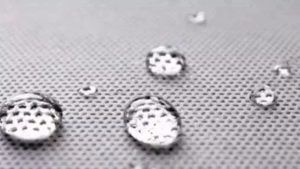
In recent years, calcium carbonate-based filler masterbatches have been widely used in the production of plastics and non-woven fabrics. In a short period of time, non-woven fabric enterprises in various places have developed rapidly, business is booming, and competition is fierce.
The important reason for the rapid development of PP spunbond nonwovens is that its manufacturing method is simple and quick, the product cost is low, the quality is stable, and the market competitiveness is strong. In order to reduce the amount of polypropylene used and reduce carbon dioxide emissions, producers will also add calcium carbonate filler masterbatch in the production process to give it more advantages in terms of price, processing process, production cost, and physical indicators. From this point of view, the application field and sustainable development of PP spunbond nonwovens have been greatly expanded. Energy saving and emission reduction are the inevitable trend of the development of spunbond nonwovens industry.
Manufacturing process of calcium carbonate in PP spunbonded nonwoven fabric
The raw material used in the production of spunbonded non-woven fabrics is high-melt-index polypropylene, which is evenly mixed with calcium carbonate filler masterbatch. It enters the screw extruder from the hopper to be extruded and melted, then enters the continuous pre-filter, and then enters the spinning box. .
The melt enters the spinning head through the metering pump, and is accurately metered by the metering pump, and the melt is quantitatively transported to the spinneret, and forms a continuous stream of melt through the spinneret hole, that is, the primary fiber.
The as-spun fibers are then cooled by quenching air and drawn by airflow to form filament bundles. The filament bundle is reciprocated by the swing roller, and evenly laid on the running web forming curtain to form a fiber web.
Why choose calcium carbonate as filler masterbatch?
Calcium carbonate is an extremely important inorganic chemical product, which is widely used in plastics, rubber, paint, paper and other industries. The characteristics of several fillers commonly used in industry are as follows:
Calcium carbonate: The purpose of adding filler masterbatch to spunbonded non-woven fabric is to reduce costs. From the experience of plastic resin modification and cost reduction, it is the cheapest and easy to obtain. It looks like a white, odorless powder. The relative density is 2.71, the refractive index is 1.65, and the Mohs hardness is 3.
Kaolin: easy to disperse, relatively higher price than calcium carbonate, white in appearance, relative density of 2.6, and refractive index of 1.56.
Talc powder: easy to disperse, has a certain lubricity to equipment during processing, and is a white powder with solid crystals. I think the density is between 2.7 and 2.8, and the price is relatively expensive.
Mica powder: The relative whiteness is lower, because mica powder is non-toxic and can be used in food contact products, the relative density is between 2.8 and 3.0, the refractive index is 1.59, and the Mohs hardness is 3.
Wollastonite: The relative density is 2.9, the refractive index is 1.63, and the Mohs hardness is 4.5. The biggest advantage is that it does not absorb moisture and has little effect on the color masterbatch.
Therefore, in the non-woven fabric production process, the fillers generally selected are generally calcium carbonate, and a little kaolin or wollastonite is appropriately added in the production process to increase the dispersion and transparency.
Generally, the mesh number of calcium carbonate is more than 1500 mesh, and it should not be too fine, because the price of too fine mesh is high, and the superfine powder generally cannot be dispersed.
